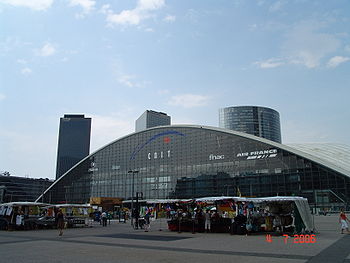
Center of New Industries and Technologies
Encyclopedia

French language
French is a Romance language spoken as a first language in France, the Romandy region in Switzerland, Wallonia and Brussels in Belgium, Monaco, the regions of Quebec and Acadia in Canada, and by various communities elsewhere. Second-language speakers of French are distributed throughout many parts...
: Centre des nouvelles industries et technologies, better known as the CNIT), located in Puteaux
Puteaux
Puteaux is a commune in the western suburbs of Paris, France. It is located in the heart of the Hauts-de-Seine department from the center of Paris....
, France
France
The French Republic , The French Republic , The French Republic , (commonly known as France , is a unitary semi-presidential republic in Western Europe with several overseas territories and islands located on other continents and in the Indian, Pacific, and Atlantic oceans. Metropolitan France...
, is one of the first buildings built in La Défense
La Défense
La Défense is a major business district of the Paris aire urbaine. With a population of 20,000, it is centered in an orbital motorway straddling the Hauts-de-Seine département municipalities of Nanterre, Courbevoie and Puteaux...
in Paris
Paris
Paris is the capital and largest city in France, situated on the river Seine, in northern France, at the heart of the Île-de-France region...
, France. It functions as convention center, though it also houses the main offices such as that of FNAC
FNAC
FNAC may refer to:* the fine needle aspiration cytology, a medical diagnosis technique;* the Fnac, a French cultural and consumer retailer...
, a media and electronics retailer found throughout Paris, as well as a Hilton hotel.
History
The initial construction of the building took place between 1956 and 1958 with the first concrete poured on May 8. Its architects were Robert Edouard Camelot, Jean de MaillyJean de Mailly
Jean Pierier of Mailly, called Jean de Mailly, was a Dominican chronicler working in Metz in the mid-13th century. In his Latin chronicle of the Diocese of Metz, Chronica universalis Mettensis, the fable of Pope Joan first appears in written form....
, Bernard Zehrfuss
Bernard Zehrfuss
Bernard Louis Zehrfuss was a French architect.-Life:From a family that had fled from the Alsace in 1870 after the Franco-Prussian War, Zehrfuss's father was killed in the First Battle of the Marne in 1914...
accompanied by the engineer Jean Prouvé
Jean Prouvé
-Images:**- External links :***...
for the exterior. The structural engineer for the concrete shell was Nicolas Esquillan.
At the time of its construction, the La Defense business district did not exist and the site for the building was at the roundabout or "rond point" of La Defense where the old Zodiac Aerospace factory was situated. The site was named for a statue called "La Defense De Paris" by the sculptor Louis-Ernest Barrias
Louis-Ernest Barrias
Louis-Ernest Barrias was a French sculptor of the Beaux-Arts school.He was born in Paris into a family of artists. His father was a porcelain-painter, and his older brother Félix-Joseph Barrias a well-known painter...
which was situated on a natural hill between the towns of Puteaux and Corbevois. This statue, originally erected in 1883, has now been moved to the west of the La Defense plaza.
Originally conceived as an exhibition center for the French machine tools industry, the building was inaugurated by General, and soon to be President, Charles de Gaulle
Charles de Gaulle
Charles André Joseph Marie de Gaulle was a French general and statesman who led the Free French Forces during World War II. He later founded the French Fifth Republic in 1958 and served as its first President from 1959 to 1969....
on 12 September 1958.
Construction of the La Defense plaza
In 1978 a great plaza was constructed next to the site of the CNIT building. The newly raised pedestrian precinct covered the railway station, all of the tracks and a good third of the height of the CNIT building. The entrance ways, characterized by rectangular blocks, were removed.The La Defense plaza now covers a large area to the south of this building and is three stories above ground level.
Refurbished in 1988
During 1988 the space covered by the CNIT building was completely emptied and refurbished to encompass 200,000 square meters instead of the initial 100,000 square meters. Only the vault was retained from the original construction. The internal structure which now contained new offices and a luxury hotel (currently the Paris La Defense Hilton) were radically changed.Refurbished in 2009
A major refurbishment of the CNIT was finished in summer 2009 increasing the public space within the building by the re-opening of the lower floor which now contains new shops and restaurants. During this work, some of the more esthetic features of the 1988 redesign, including the striking triangular door handles that copied the shape of the building were lost to more modern but otherwise unremarkable fittings.Architecture & Engineering
This building is notable for being the largest unsupported concrete span enclosed space in the world. Its triangular structure is supported on three points that are two hundred and eighteen meters (715') apart. The centre of the roof is more than forty six meters (151') above the ground. Situated on the northern side of the La Defense plaza, this is one of the most eye catching buildings in modern architecture, being constructed of reinforced concrete in an innovative double shelled design with internal ribs.Internally, the impressive vaulted roof is entirely unencumbered by columns or girders and the buildings within the space provide no structural support whatsoever, seeming rather to hang from the span itself.

